 |
Site created 12/15/97.

page created: 10/28/08
 back to Page One Barrie Maxwell - Main Page |
Classic Reviews Round-Up #49 and New Announcements (continued) New Reviews - New Editions of Previous Releases The 1958 Best Picture winner, Gigi, has also now received its full due on DVD with the Warner Bros. release of a new 2-Disc Special Edition. The film's DVD history mirrors that of An American in Paris, with a version first issued by MGM in 1999 and that version reissued under the Warner Bros. label in 2000. 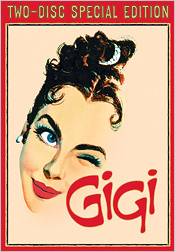
Both sported the same vibrant but often soft-looking and dirt- and debris- covered 2.35:1 anamorphic transfer, a limited Dolby 3.0 audio track, and supplements consisting of a trailer and background booklet (the latter not included on the Warner reissue). (Warners subsequently issued the same release again as part of at least one box set.) The new special edition improves on the image transfer substantially, although it doesn't look quite as good as the efforts on An American in Paris. That's probably due to the nature of the Gigi's Eastmancolor origins (known here as Metrocolor) as opposed to the other's three-strip Technicolor. The colours are very vibrant but at times the image looks a tad soft. Most of the dirt and debris on the old transfer has been excised. A Dolby 5.1 sound track has some good directionality and modest use of the surrounds during the musical numbers. The supplements include audio commentary by film historian Jeannine Basinger and Leslie Caron, a new making-of documentary, and most interestingly, the 1949 non-musical first film version of Gigi starring Daniele Delorme in the title role. The French-made film is in rather rough shape, but is fascinating to watch as a comparison piece. A short, cartoon, and trailer round out the poackage. Highly recommended, with the only caveat being that if you're into Blu-ray, you may wish to wait for the high definition version that Warners has promised for release in early 2009. 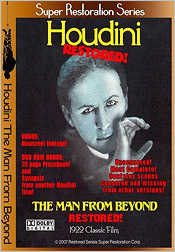
The 1922 Houdini film, The Man from Beyond, was previously issued on DVD-R in 2007 by Restored Serials Super Restoration Corporation. My review of that release noted some obvious problems with the transfer, specifically significant contrast and video noise issues. Responding to my and other reviews, Restored Serials has now revisited the release to address its deficiencies and the results are quite impressive. Many of the contrast and video noise problems have been addressed by virtue of a new transfer and the use of more advanced software to stabilize and clean up the images. The results are a noticeably sharper and cleaner picture that no longer distracts one from being immersed in the story. The company has also applied new speed adjustment software that improves the fluidity of the narrative and in the process has expanded the film length from 62 to 80 minutes. The supplement pot has been sweetened too, with DVD-ROM content of almost 300 pages of annotated script material for Houdini's Master Mystery Serial being added to the newsreel coverage of Houdini escaping from a straitjacket and the 20-page pressbook for The Man from Beyond that both appeared in the original release. The new disc is also replicated on TDK Armor for improved scratch resistance. I suggested that despite its deficiencies, the original release was still worth supporting. I give this improved release an unreserved recommendation. Those looking for the new version should note that the cover art is the same as before, but the 2008 copyright date is clearly noted on the front cover as is the inclusion of the added bonus content. New Reviews - First-Time Releases Fox's latest wave of film noir has only one title that truly fits - Road House (1948). The others - Boomerang (1947) and particularly Moontide (1942) - have marginal noir pedigree at best, mainly their stark lighting and Boomerang's documentary-style narration. 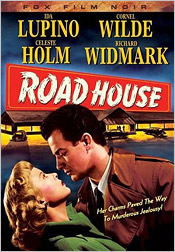 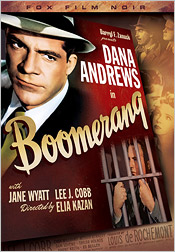
I've had a chance to look at both Road House and Boomerang. Road House takes us to a roadhouse in a town near the Canadian border where owner Jefty (Richard Widmark) has taken on a new singer, the husky-voiced Lily (Ida Lupino) with whom he soon falls in love. Jefty's best friend Pete (Cornel Wilde) manages the roadhouse and initially he resists Lily, only to eventually also fall in love with her. When Jefty finds out, he concocts a plan to punish both Pete and Lily leading to a fatal encounter outside Jefty's cabin in the woods. The film is Lupino's for its first half, its sharp dialogue between her and both Widmark and Wilde crackling with tension and innuendo. The woman can't sing, but she sure puts across a song! Widmark comes increasingly to the fore in the second half as his anger erupts into one of his Tommy Udo-type riffs. Wilde is the stabilizing influence throughout. The film's chief noir characteristics aside from its moody roadhouse lighting are embodied by Jefty who provides both a physical and mental assault on the protagonists and by the remote locations that accentuate the increasingly alienated Pete and Lily. Boomerang was originally announced by Fox as an entry in its Film Noir series several years ago, but then withdrawn at the last minute. It's now finally appeared and sports the #16 spine number that was intended originally. Directed by Elia Kazan, it's a terrific film based on a true story and features a very fine performance by Dana Andrews (following on his equally good work in The Best Years of Our Lives). Andrews plays a state prosecutor who has doubts about the guilt of a drifter suspected of murdering a well-loved local minister. In addition to Andrews, the film is littered with fine portrayals including Lee J. Cobb's police chief, Douglas Kennedy's drifter, Ed Begley's corrupt city official, and Sam Levene's reporter. Unfortunately, Jane Wyatt is wasted in a minor role as Andrews' wife. The best sequence of the film is Andrews' courtroom attempt to unravel the evidence against Kennedy. Kennedy's drifter is film noir's alienated veteran, but Boomerang is only incidentally about his story. Both films offer fine full screen transfers that as with most Fox classics, are typically sharp, clean, and nicely detailed with an appropriate amount of grain. The mono sound on each is in good shape. Noir experts James Ursini and Alain Silver deliver an excellent audio commentary on Boomerang while noir expert Eddie Muller and film critic Kim Morgan do similar honours for Road House. The latter‘s disc also includes a nice featurette on Ida Lupino and Richard Widmark at Fox. Both releases are recommended. 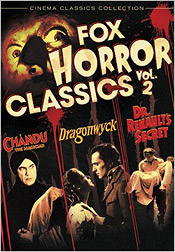 Fox has also been busy on the horror side of things with its release of Fox Horror Classics: Volume 2. The box set includes Chandu the Magician (1932), Dr. Renault's Secret (1942), and Dragonwyck (1946) - with each title accorded its own disc and separate thincase. Neither Chandu the Magician nor Dragonwyck are really horror films, but if it takes that designation to get them out on disc, why quibble? Dragonwyck is the class of the set - an impressive Gothic suspense thriller in which the rich Nicholas Van Ryn who invites his distant cousin Miranda (Gene Tierney) to live at his New York estate. There despite observing Van Ryn's lack of care for fellow humans and his mysterious retreats to the upper levels of the mansion, Miranda falls in love with Van Ryn. After delivering him a son, the relationship begins to deteriorate and Miranda's life is soon at risk. The film was based on Anya Seton's best-selling novel and was accorded top notch production values by Fox. First-time director Joseph L. Mankiewicz injects considerable suspense and a continual air of mystery into the film. Most impressive is a cast that features a quintessential Vincent Price portrayal as Van Ryn. Although billed below the title, his performance takes over the film in its second half. Top-billed Gene Tierney somewhat dominates the first half but she's eventually eclipsed by Price. Look also for an effective supporting turn by Walter Huston as Miranda's God-fearing father. The full screen transfer delivers a sparkling image - sharp, excellent shadow detail, and a modest level of grain. The mono sound is in good shape. Supplements are highlighted by an entertaining audio commentary by author Steve Haberman and filmmaker Constantine Nasr, an isolated score track, and a short but generally informative making-of featurette. Dr. Renault's Secret is a short (58 minutes) B horror pleasure with J. Carrol Naish starring as a mysterious aide to French scientist Dr. Renault (the always-welcome and reliable George Zucco). His secret is gradually revealed during the course of the visit by an American scientist (John Shepperd) who has come to marry Renault's niece (Lynne Roberts). There's nothing very startling or even particularly original about the film, but it is briskly told and well-acted by all involved - an efficient effort by Fox's B unit under the control of Sol Wurtzel. It's great to see Fox allowing more obscure titles like this to see the light of day on DVD. The film looks and sounds as inviting on DVD as did Dragonwyck. A making-of featurette highlights the supplements. An early Bela Lugosi outing such as in Chandu the Magician is always welcome, although in this case the film is somewhat of a disappointment. The title character is actually played by Edmund Lowe, in rather wooden fashion, with Lugosi giving the film its only spark as the crazed Roxor set on destroying the world. The direction by William Cameron Menzies translates into some very interesting set decoration and camera work, as one might expect, but otherwise fights a losing battle against the weak script with its at times awkward dialogue. Lugosi would later star as the Chandu character in the 1934 Principal 12-chapter serial The Return of Chandu - a production later edited into two separate features under the titles The Return of Chandu and Chandu on the Magic Isle, both released in 1935. On disc, Chandu the Magician isn't as good looking as the two other titles in the box set, but it still looks quite acceptable. Some scratches and other debris are very evident, but the image is clear enough if a little soft at times. The film sports a fine audio commentary by Lugosi author Gregory William Mank, a featurette appreciation of the film, and a stills gallery. The box set is easily recommended. Note that the films are not available separately. 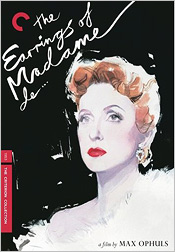
German-born but later a French citizen, director Max Ophuls' star has gradually risen in the decades subsequent to the release years of his films (1930-1955). He was often criticized for being consumed with stylistic concerns over subject matter, something only corrected as the study of film history and analysis began to evolve in the 1960s. Now his characteristic attention to elaborate camera movement (especially extended tracking shots), ornate décor, and objects intervening between the camera and the film's characters are recognized as intrinsic parts of the stories his films told (ones most notably rooted in the female consciousness). Ophuls' most well-known films fall into two periods - an American one in the late 1940s (including Letter from an Unknown Woman, Caught and The Reckless Moment) and the French one of the early 1950s (four films culminating in Lola Montes, 1955). Now the three other films of the latter period have been accorded releases in the Criterion Collection. I've taken a look at The Earrings of Madame De… (originally released as simply Madame De…) which is one of Ophuls' most satisfying works. Based on a story by Louise de Vilmorin, the story revolves around the central characters of a French general (Charles Boyer), his flirtatious wife (Danielle Darrieux, the Madame De… of the title), and her suitor (Vittorio De Sica). When Darrieux sells a pair of diamond earrings in order to pay off some debts, it sets off a chain of events in which the earrings keep reappearing, to first comedic but eventually tragic effect. Ophuls' fluid camera was never more in evidence in a film yet never more unobtrusive because of its inseparability from the constantly progressing and shifting narrative. Darrieux delivers a very satisfying performance as the title character, but one should not overlook the subtlety of Boyer's much put-upon yet sympathetic husband. The film is presented on DVD full frame as originally shot and offers a very nicely-detailed image that's both sharp and characterized by a comprehensive gray scale. Blacks are perhaps not quite as deep as one might like, but the image is free of all but a few minor blemishes. The mono sound is in good shape with only some minor hiss in evidence. The white subtitling is easy to read and quite comprehensive. The best supplement is a very interesting and entertaining commentary by film scholars Susan White and Gaylyn Studlar. Included also is a fine 2005 interview with assistant director Alain Jessua; shorter vintage interviews with a couple of Ophuls collaborators and with Louise de Vilmorin; an introduction by director Paul Thomas Anderson; and a 78-page booklet containing an appreciation by Molly Haskell and the original de Vilmorin story. Very highly recommended. 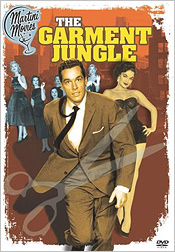 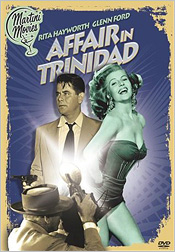
Sony has embarked on what appears to be a new line of releases dubbed "Martini Movies". The first wave of these has been released, comprising five titles from the 1950s-1970s time period, and I've had the opportunity to look at two of them - The Garment Jungle and Affair in Trinidad. By the way, what any of these films has to do with martinis is unclear, but if that's the moniker needed to get them released, I'm all for it. The Garment Jungle (1957) is a terrific little film noir directed by Vincent Sherman who replaced Robert Aldrich part way through the production. The story involves efforts to unionize a garment factory in New York whose owner (Lee J. Cobb) has successfully kept the union at bay through the help of a criminal protection gang headed by Richard Boone. The issue is brought to a head when Cobb's son (Kerwin Matthews), a Korean War vet, returns to work in his father's company. The war-weary returning vet is the key noir figure, ironically faced with a corrupt system within the country for whom he fought against a corrupt regime overseas. Cobb is one of the familiar players in film noir and Richard Boone stands out as the menacing face of the noir underworld. Many familiar supporting faces of the era have roles, such as Robert loggia, Joseph Wiseman, Harold J. Stone, and Willis Bouchey. The script (by Harry Kleiner) and the cast as a whole are particularly strong, and the Sherman/Aldrich direction maintains a high level of suspense throughout. The film is presented in a 1.85:1 anamorphic transfer that looks excellent. It's crisp and clean with very good shadow detail and contrast. A modest level of grain imparts a nice film-like look. The mono sound is in good shape. The only supplement of note is the theatrical trailer. There are also two brief and silly promo pieces for the films in the Martini Movies series. Recommended. Affair in Trinidad (1952) attempts to recapture the feeling of Gilda (1946) with Glenn Ford and Rita Hayworth being reteamed. Ford's character arrives in Trinidad seeking his brother's killer. A chief suspect is his brother's widow (Hayworth) who is an entertainer at one of the local night spots, but unknown to Ford, also working undercover for the local police. There's a gang of international spies mixed up in the plot as Ford and Hayworth eventually come together in a common cause. The film was rife with dissention throughout the production as Hayworth had just come back to making films after a four year absence while married to Prince Aly Khan and was distinctly unhappy with the script. With the similarity to Gilda, Affair in Trinidad is a pretty predictable film, but Rita Hayworth manages to hold centre-stage throughout with all the old Gilda-like sheen and the chemistry with Ford is still there. The production values are high and despite the production difficulties, the film made money, leading Columbia to commit to a string of Technicolor outings for Hayworth over the next four years (Salome, Miss Sadie Thompson, Fire Down Below, Pal Joey). The full screen image looks very nice - sharp with fairly deep blacks and some modest grain evident. There's only minor speckling and the odd scratch present. The mono sound is in good shape. The only supplement of consequence is the theatrical trailer. Worth a rental at most, unless you're a die-hard Rita Hayworth (or Glenn Ford) fan. 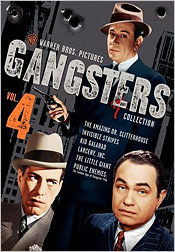
The latest classic set from Warners is Warner Bros. Pictures Gangsters Collection: Volume 4. It contains five classic titles (The Amazing Dr. Clitterhouse, Invisible Stripes, Kid Galahad, Larceny Inc., The Little Giant) and a new feature-length documentary (Public Enemies: The Golden Age of the Gangster Film), each packaged in its own Amaray case. Each title is also available for purchase separately. The key Warner gangster films have already been released on DVD, so now it's good to see the studio digging deeper into the catalogue to bring out lesser-known (to some) but still fine gangster titles. This set is effectively an Edward G. Robinson one as he stars in four of the films (The Amazing Dr. Clitterhouse, Kid Galahad, Larceny Inc., and The Little Giant). Humphrey Bogart appears in three of them in featured roles (The Amazing Dr. Clitterhouse, Invisible Stripes, and Kid Galahad). George Raft stars in one (Invisible Stripes). These three players, along with James Cagney (who took pride of place in Volume 3 of the gangster sets), get appreciable screen attention in the new feature documentary. All five films are quite enjoyable, but The Amazing Dr. Clitterhouse (1938) and The Little Giant (1933) hold the most interest. The former has a somewhat offbeat plot in which Robinson plays a scientist who wants to probe the criminal mind as the basis for a book and so engages in a criminal activity himself as a way to gain first-hand information. The film's denouement is unexpected if somewhat bizarre. The Little Giant is an entertaining comedy riff on Robinson's Little Caesar role and one he would revisit in such films as Brother Orchid, among others. The most welcome thing about the film is its mere appearance on DVD; it's one of a string of early Robinson titles for Warners that have never been available on any home video medium. We can only hope that it presages the DVD release of many other such titles - for example, Five Star Final, The Hatchet Man, Two Seconds, Tiger Shark, Silver Dollar, etc. Kid Galahad (1937) is for many a long-awaited title for DVD coverage. The film has long been buried under the TV title The Battling Bellhop as a result of the much inferior Elvis Presley remake in 1962 having usurped the Kid Galahad title. It delivers good roles for each of Robinson (as a fight promoter), Bette Davis (as Robinson's moll), and Bogart as a rival promoter. The title role goes to Wayne Morris as a bellhop being groomed for the heavyweight title. Boxing was a favourite theme or sub-theme for many 1930s gangster films and Kid Galahad proves to be one of the best under Michael Curtiz's atmospheric and terse direction. Larceny, Inc. (1942) is one of the comedy/gangster films that Robinson seemed to do well. This one is actually based on a Broadway play by Laura and S.J. Perelman. Robinson and his gang run a luggage shop as a front for stealing money from the bank next door - all in the aid of financing a dog track that ironically, Robinson hopes to run as a legal operation as a way of going straight after having just been released from prison. The casting of Edward Brophy, Broderick Crawford, and Jack Carson among others in supporting roles fits the film's context very well. Invisible Stripes (1939) seems to be the least interesting of the five films, at least for me. Perhaps it's the knowledge that Bogart had been doing these sorts of second-banana gangster roles for so long and his breakthrough films were so close that my patience for Invisible Stripes is lacking. William Holden has a very early role for him in the film and his rawness sticks out, again in the context of what we all know he later became capable. George Raft has the lead as an ex-con trying to go straight despite society appearing to conspire against him. All five films are presented full screen as originally shot and all look very presentable with generally sharp transfers, good shadow detail, and appropriate amounts of grain. Kid Galahad looks a little softer and more prone to speckles and scratches than the others. The mono sound on all is quite good. Warners certainly hasn't stinted on the extras. Each title receives an audio commentary (the ones by Drew Casper and Richard Jewell on The Amazing Dr. Clitterhouse, and by Alain Silver and James Ursini on Invisible Stripes struck me as the best) and a welcome "Warner Night at the Movies" suite of shorts/newreel/cartoons/trailers. For those interested in the supplementary trailers which sometimes presage Warners' future DVD plans for such titles, they are: Hard to Handle (1933), It's Love I'm After (1937), Racket Busters (1938), You Can't Get Away with Murder (1939), and The Big Shot (1942). Finally, the new feature-length documentary Public Enemies: The Golden Age of the Gangster Film may be considered a major supplement in its own right. Over its 106-minute running time, it delves into all facets of the gangster film principally during its 1930-1950 heyday. It's comprised mainly of film clips and interview footage by a wide range of film historians, biographers, filmmakers, and critics. Unfortunately the passage of time has precluded the participation of people who were actually involved in the films under discussion. For those with more than a passing knowledge of the films under discussion, there's little new to be gleaned here. Those new to the films will find the effort to be a good overview, however. I must confess that I've grown a little tired of seeing the same faces show up on all such retrospective programs. Some have genuine insight, but others are obviously self-styled experts, often merely parroting ideas and viewpoints read in texts published by others. This judgement may be somewhat unfair because the interview clips are often so edited that individuals aren't given the time to elaborate on their thoughts to any great extent - a sad sign of the times and the apparent desire to cater to short attention spans that's reflected in the editing of too many feature films of our era. The new Warner Bros. Pictures Gangsters Collection: Volume 4 is highly recommended. |
on to Page Three
 |
| Site
designed for 1024 x 768 resolution, using 16M colors and .gif 89a
animation. © 1997-2015 The Digital Bits, Inc., All Rights Reserved. billhunt@thedigitalbits.com |